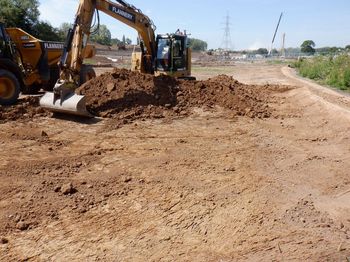Site Data from Construction Integrated Archaeological Recording at Copthall North Gate 2, West Ruislip, Hillingdon, 2021-2022 (HS2 Phase One)
Archaeology Wales, High Speed Two Ltd., 2025. https://doi.org/10.5284/1126508. How to cite using this DOI
Data copyright © High Speed Two Ltd. unless otherwise stated
This work is licensed under a The Open Government Licence (OGL).
Primary contact
High Speed Two Ltd.
2 Snowhill
Queensway
Birmingham
B4 6GA
United Kingdom
Tel: 08081 434 434
Resource identifiers
- ADS Collection: 6314
- DOI:https://doi.org/10.5284/1126508
- How to cite using this DOI
Introduction

This collection comprises images and site records from Construction Integrated Recording (CIR) at Copthall North Gate 2, West Ruislip. Work was undertaken by Archaeology Wales between December 2021 and June 2022 on behalf of High Speed Two Ltd.
Project Summary
The CIR forms part of Phase One of the High Speed 2 (HS2) rail project, which was granted Royal Assent in 2017 as the High-Speed Rail (London - West Midlands) Act. Phase One runs 230 km from Euston Station in London to Curzon Street in Birmingham. This particular evaluation was preceded by two further phases of work within the area of Copthall North; the first being undertaken by Archaeology Wales in December 2021, which identified no features or artefacts of archaeological significance; and the second by Archaeology Wales in June 2022, again, identified no features or artefacts of archaeological significance.
The general aims and objectives of the project were:
- To determine the presence/absence of previously unknown archaeological assets in the evaluation areas by a programme of trial trench evaluation.
- To archaeologically excavate and record all significant archaeological features within the evaluation areas, in order to clarify the nature, date, extent and survival of any remains revealed and thus contribute to understanding of their heritage significance.
The evaluation was to provide a permanent archaeological record for the purposes of contributing to specific GWSI: HERDS Specific Objectives (see below).
- To obtain dating and environmental evidence (where possible) through retrieval of artefactual and Eco factual evidence.
- To carry out post-excavation assessment and analysis of recovered material.
The evaluation was designed to address the following Knowledge Creation Objectives determined by CSJV ahead of two previous phases of work:
- KC5: Identify settlement location and developing models for settlement patterns for the Mesolithic, Neolithic and early Bronze Age.
- KC6: Understanding the evidence for change in the environment and management of the landscape for the Mesolithic and early Neolithic Periods.
- KC7: Exploring the degree of continuity that existed between Late Mesolithic and Neolithic communities in terms of population mobility and subsistence strategies.
- KC11: Does the high density of prehistoric settlement evidence in the Colne Valley reflect a genuine focus of activity or does it reflect a bias in the archaeological record?
- KC40: Identify patterns of change within medieval rural settlement from 11th to mid-14th century.
Re-use Value
The archaeological potential of this area is considered to be negligible and does not add to any of the Knowledge Creation questions outlined in the specific objectives.






